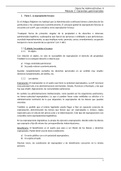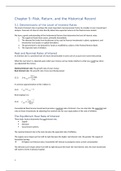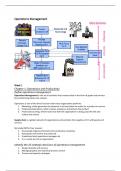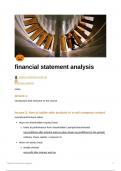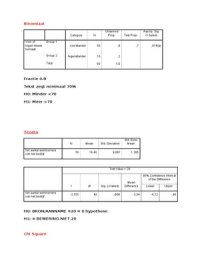Schumpeter 1937 – economic development
Attempt to construct theoretic model of the process of economic change in time:
- How does the economic system generate the force which incessantly transforms it?
A source within economic system itself constantly disrupts equilibrium. If so, then there
must be an economic theory of economic change which does not merely rely on external
factors propelling the economic system from one equilibrium to another. Arguments in book:
- Eliminate system of equilibrium (such as production function of costs) Notion of
creative destruction: fall incumbents because new doing something different
- Theory of imperfect competition (monopolistic rents, temporarily) describes
behaviour of entrepreneur, evade competition by doing something different
- Dynamic character (given vs. rate of change of quantiles & actual vs expected quantiles)
Doing something different technological change incentives for entrepreneurs
Nelson & Winter call this paradigm shift a constant disequilibrium
Nelson & Winter 1977 – In search of a useful innovation theory
Orthodox theory Heterodox theory
Neo-classical economics (certainty) Evolutionary economics (uncertainty)
Rational decisions are made on bases of Search heuristics by R&D to strive for
profit maximisation (optimisation) diversifying tech variation
Technological change is assumed to be Technological change is a core property of
exogenous to firms (production function) economic systems (endogenous)
Economic equilibrium Economic disequilibrium
Generalised policy Demand for sector/tech. specific policy
Does not explain the concept of the S-curve; Natural trajectories directions of R&D
why inferior but new tech is important (general & specific) a.k.a path dependency
Strive for efficiency (productivity growth) Explain differences across sectors
In orthodox technology affects sectors equally differences, not explainable by orthodox:
- R&D investment decisions cannot be made against a clear set of alternatives
(fundamental uncertainty)
- R&D intensity and the nature of the R&D process within sectors (technological
regimes/paradigms)
- Sources of R&D spending and rates of internalising R&D results (institutional
environment)
Explaining differences: productivity growth puzzle In search of a useful theory:
- Innovation is inherently stochastic: variation, selection, retention
- Selection environment: the institutional constitution of sectors does matter;
technological regimes (Nelson & Winter) / paradigms (Dosi) and innovation systems
, Dosi 1988 – The nature of the innovative process
Place technical change at the centre of theory of economic change (determinism):
- Internal to the dynamics of the economics principle
- Technological factors in competitiveness and growth
Stylised facts on the innovative process (rises three main research questions see book):
- Innovation involves uncertainty, outcomes cannot be known ex ante
o Techno-economic problem solution procedures are unknown
o Impossibility of precisely tracing consequences to actions
- Reliance of major new technological opportunities on advances scientific knowledge
(this is quite an orthodox like a linear model)
- Search activities change; increasing complexity of research and innovative activities
o In favour of formal organisations as opposed to individual innovators
o Formal research activities seem to be integrated in manufacturing firms
- Learning-by-doing and learning-by-using, informal activities to overcome bottlenecks
- Technological change are not flexible reactions to changes in the market conditions
o Technical change is often defined by technology already in use (vs. variation)
o Nature of technologies themselves determine changing economic conditions
o Technical change is cumulative knowledge activity of technologists (engineers)
Universal vs. specific, articulated vs. tacit, and public vs, private selection environment
Technological paradigm: a “pattern” for solution of selected techno-economic
problems, consisting of both a set of exemplars (basic artefacts) and a set of heuristics
(search rules), technological paradigms define technological opportunities for further
innovations, technologists have a certain idea / heuristic to where to go (shifting of s-curve)
Technological trajectory: is the activity of technological progress along economic
and technological trade-offs defined by a technological paradigm, e.g., a trajectory of
incremental development in efficiency (S-curve itself, path dependent)
The crucial hypothesis is that innovative activities are strongly selective, finalised
in rather precise directions, often cumulative activities (which is different from previous view)
It is important to distinguish between the factors which induce, stimulate, or
constrain technical change the change in itself (inducement mechanisms see book). Every
single paradigm determines both the opportunities of technical progress and the boundaries
within which “inducement effects” can be exerted by the environment.
Technological change (as shortcut) either dependent on demand-pull or technology push
Dosi suggests innovation relies on inter-sectoral and inter-temporal differences in
opportunities of innovation, degree of appropriability of innovation, and patterns of demand
The emergence of new paradigms and the diffusion of theirs effects is possibly the main
reason why decreasing returns do not set in throughout the economy
Attempt to construct theoretic model of the process of economic change in time:
- How does the economic system generate the force which incessantly transforms it?
A source within economic system itself constantly disrupts equilibrium. If so, then there
must be an economic theory of economic change which does not merely rely on external
factors propelling the economic system from one equilibrium to another. Arguments in book:
- Eliminate system of equilibrium (such as production function of costs) Notion of
creative destruction: fall incumbents because new doing something different
- Theory of imperfect competition (monopolistic rents, temporarily) describes
behaviour of entrepreneur, evade competition by doing something different
- Dynamic character (given vs. rate of change of quantiles & actual vs expected quantiles)
Doing something different technological change incentives for entrepreneurs
Nelson & Winter call this paradigm shift a constant disequilibrium
Nelson & Winter 1977 – In search of a useful innovation theory
Orthodox theory Heterodox theory
Neo-classical economics (certainty) Evolutionary economics (uncertainty)
Rational decisions are made on bases of Search heuristics by R&D to strive for
profit maximisation (optimisation) diversifying tech variation
Technological change is assumed to be Technological change is a core property of
exogenous to firms (production function) economic systems (endogenous)
Economic equilibrium Economic disequilibrium
Generalised policy Demand for sector/tech. specific policy
Does not explain the concept of the S-curve; Natural trajectories directions of R&D
why inferior but new tech is important (general & specific) a.k.a path dependency
Strive for efficiency (productivity growth) Explain differences across sectors
In orthodox technology affects sectors equally differences, not explainable by orthodox:
- R&D investment decisions cannot be made against a clear set of alternatives
(fundamental uncertainty)
- R&D intensity and the nature of the R&D process within sectors (technological
regimes/paradigms)
- Sources of R&D spending and rates of internalising R&D results (institutional
environment)
Explaining differences: productivity growth puzzle In search of a useful theory:
- Innovation is inherently stochastic: variation, selection, retention
- Selection environment: the institutional constitution of sectors does matter;
technological regimes (Nelson & Winter) / paradigms (Dosi) and innovation systems
, Dosi 1988 – The nature of the innovative process
Place technical change at the centre of theory of economic change (determinism):
- Internal to the dynamics of the economics principle
- Technological factors in competitiveness and growth
Stylised facts on the innovative process (rises three main research questions see book):
- Innovation involves uncertainty, outcomes cannot be known ex ante
o Techno-economic problem solution procedures are unknown
o Impossibility of precisely tracing consequences to actions
- Reliance of major new technological opportunities on advances scientific knowledge
(this is quite an orthodox like a linear model)
- Search activities change; increasing complexity of research and innovative activities
o In favour of formal organisations as opposed to individual innovators
o Formal research activities seem to be integrated in manufacturing firms
- Learning-by-doing and learning-by-using, informal activities to overcome bottlenecks
- Technological change are not flexible reactions to changes in the market conditions
o Technical change is often defined by technology already in use (vs. variation)
o Nature of technologies themselves determine changing economic conditions
o Technical change is cumulative knowledge activity of technologists (engineers)
Universal vs. specific, articulated vs. tacit, and public vs, private selection environment
Technological paradigm: a “pattern” for solution of selected techno-economic
problems, consisting of both a set of exemplars (basic artefacts) and a set of heuristics
(search rules), technological paradigms define technological opportunities for further
innovations, technologists have a certain idea / heuristic to where to go (shifting of s-curve)
Technological trajectory: is the activity of technological progress along economic
and technological trade-offs defined by a technological paradigm, e.g., a trajectory of
incremental development in efficiency (S-curve itself, path dependent)
The crucial hypothesis is that innovative activities are strongly selective, finalised
in rather precise directions, often cumulative activities (which is different from previous view)
It is important to distinguish between the factors which induce, stimulate, or
constrain technical change the change in itself (inducement mechanisms see book). Every
single paradigm determines both the opportunities of technical progress and the boundaries
within which “inducement effects” can be exerted by the environment.
Technological change (as shortcut) either dependent on demand-pull or technology push
Dosi suggests innovation relies on inter-sectoral and inter-temporal differences in
opportunities of innovation, degree of appropriability of innovation, and patterns of demand
The emergence of new paradigms and the diffusion of theirs effects is possibly the main
reason why decreasing returns do not set in throughout the economy

